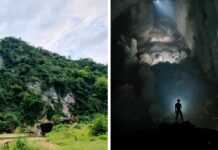The Marble Caves are a geological wonder of unsurpassed beauty, nestled amid the magnificent landscapes of Chile and Argentina. These captivating caverns, made completely of flawless marble, are delicately ornamented with the deep blue waters of General Carrera Lake, producing a stunning scene that captivates those who see it.
General Carrera Lake, commonly known as Lake Buenos Aires on the Argentine side, is a huge lake shared by the two nations in Patagonia’s northeastern area. With a surface area of 1,850 km2, 970 km2 in the Chilean Aysén del General Carlos Ibáez del Campo Region and 880 km2 in the Argentine Santa Cruz Province, it is the largest lake in Chile and the fourth largest in Argentina. The lake’s western basin drops to an astonishing 586 meters.

General Carrera Lake, which has glacial origins, is surrounded by the formidable Andes mountain range, producing a spectacular background that adds to its attraction. The lake’s waters eventually make their way to the Pacific Ocean through the meandering Baker River.
Despite the typically chilly and damp environment of the neighboring parts of Chile and Argentina, General Carrera Lake has its own microclimate with sunny weather. The small villages dispersed around the lake’s beaches, such as Puerto Guadal, Fachinal, Malln Grande, Puerto Murta, Puerto Ro Tranquilo, Puerto Sánchez, Puerto Ingeniero Ibáez, and Chile Chico in Chile, and Los Antiguos and Perito Moreno in Argentina, treasure this unusual weather pattern.
Between 1900 and 1925, the lake’s coastline portions were initially occupied by criollos and European immigrants. Volcanic eruptions from the Hudson Volcano, however, caused substantial economic difficulties, notably in the sheep herding business, in 1971 and 1991.

Access is rather easy on the Argentine side of the lake, due to a stretch of lowlands first utilized by the Tehuelches and subsequently explored by Francisco Moreno. National Route 40, which was created in the 1920s, makes it even easier to go about. The Chilean side of the lake, on the other hand, remained relatively isolated until the 1990s, when the Carretera Austral was built, linking it to the rest of Chile and bringing in a flood of tourists. In the Chilean part of the lake, a vehicle ferry service presently runs between Puerto Ingeniero Ibáez and Chile Chico.
The Marble Caves exist as a witness to the miracles of geological development among the natural beauties of General Carrera Lake. These caverns, located in Chile Chico’s commune of Port Calm (Puerto Tranquilo), have a distinctive configuration sculpted by the lake’s unrelenting activity against the marble peninsula. Visitors can go on a half-hour navigation adventure inside the caverns by boat, depending on weather conditions.

The spectacle that awaiting you is nothing short of spectacular. The gleaming marble walls, polished over time by the gentle caress of the water, create an unearthly ambience that makes an unforgettable impression on all who witness it. These calcium carbonate structures have properly been designated as a Natural Sanctuary (Santuario de la Naturaleza).
The fascination of the Marble Caves is enhanced by the lake’s interesting blue tint. The massive General Carrera Lake is fed by many glaciers in the Patagonian Andes. Because glacial ice includes minute particles, as it melts, the particles remain suspended in the water, causing turbidity. As a result, glacier meltwater refracts the blue portion of sunlight, giving General Carrera Lake its distinctive blue tint.

The Marble Caves were formed as a result of the contact between the marble and the blue water of the lake. Because marble is slightly soluble in water, a process of solution began once the lake reached its current level. The marble decomposed more quickly at the water’s surface, causing cracks inside the marble to expand, eventually giving rise to an incredible assortment of caverns, mazes, columns, and tunnels within the marble during a very short geological era.
The Marble Cathedral and Marble Chapel are two of the most notable buildings. Marble Cathedral is a tiny island on the peninsula, but Marble Chapel is a marble island on the northern coast. Visitors may discover these natural wonders by going beneath the islands through mazes and tunnels, an experience that will definitely leave them speechless.
Finally, the Marble Caves on General Carrera Lake are awe-inspiring examples of nature’s creative force. These caverns, formed throughout time by the beautiful dance of marble and glacial rivers, are a monument to the complex marvels that the natural world can make. Those who are lucky enough to set foot in this paradise will remember floating over the gleaming marble walls for the rest of their lives.






